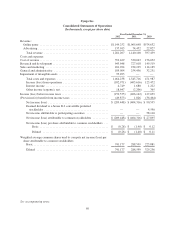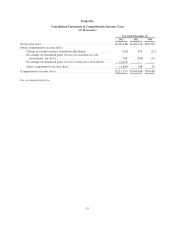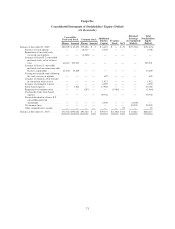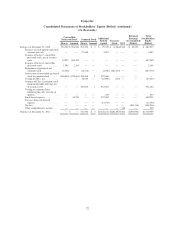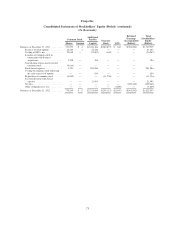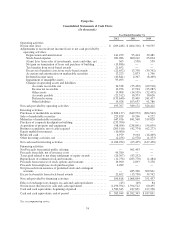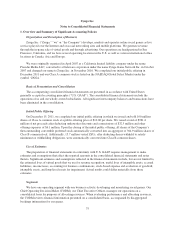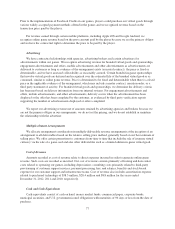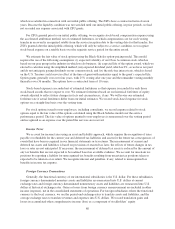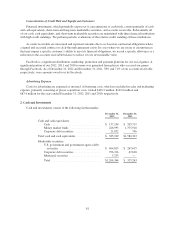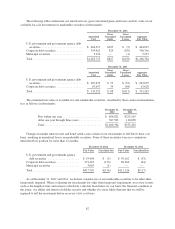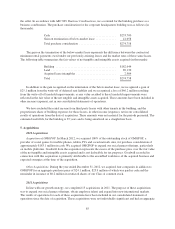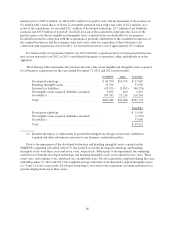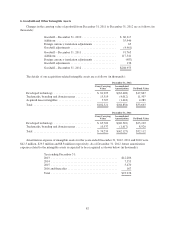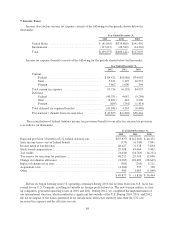Zynga 2012 Annual Report Download - page 87
Download and view the complete annual report
Please find page 87 of the 2012 Zynga annual report below. You can navigate through the pages in the report by either clicking on the pages listed below, or by using the keyword search tool below to find specific information within the annual report.Business Combinations
We account for acquisitions of entities that include inputs and processes and have the ability to create
outputs as business combinations. We allocate the purchase price of the acquisition to the tangible assets,
liabilities, and identifiable intangible assets acquired based on their estimated fair values. The excess of the
purchase price over those fair values is recorded as goodwill. Acquisition-related expenses and restructuring
costs are expensed as incurred. During the measurement period, we record adjustments to the assets acquired and
liabilities assumed with the corresponding offset to goodwill. After the measurement period, which could be up
to one year after the transaction date, subsequent adjustments are recorded to our consolidated statements of
operations.
Goodwill and Indefinite-Lived Intangible Assets
Goodwill and indefinite-lived intangible assets are carried at cost and are evaluated annually for
impairment, or more frequently if circumstances exist that indicate that impairment may exist. When conducting
our annual goodwill impairment assessment, we perform a quantitative evaluation of whether goodwill is
impaired using the two-step impairment test. The first step is comparing the fair value of our reporting unit to its
carrying value. We consider the enterprise to be the reporting unit for this analysis. If step one indicates that
impairment potentially exists, the second step is performed to measure the amount of impairment, if any. We
record the amount by which the carrying value of the goodwill exceeds its implied fair value, if any, as
impairment.
We test recoverability of indefinite-lived intangible assets using a qualitative approach on whether it is more
likely than not that the fair value of the intangible asset exceeds its carrying value. If the asset is considered to be
impaired, the amount of any impairment is measured as the difference between the carrying value and the fair
value of the impaired asset.
Other Intangible Assets
Other intangible assets are carried at cost less accumulated amortization. Amortization is recorded over the
estimated useful lives of the assets, generally 12 to 24 months.
Impairment of Long-Lived Assets
Long-lived assets, including other intangible assets (excluding indefinite-lived intangible assets), are
reviewed for impairment whenever events or changes in circumstances indicate an asset’s carrying value may not
be recoverable. If such circumstances are present, we assess the recoverability of the long-lived assets by
comparing the carrying value to the undiscounted future cash flows associated with the related assets. If the
future net undiscounted cash flows are less than the carrying value of the assets, the assets are considered
impaired and an expense, equal to the amount required to reduce the carrying value of the assets to the estimated
fair value, is recorded in the consolidated statements of operations. Significant judgment is required to estimate
the amount and timing of future cash flows and the relative risk of achieving those cash flows.
Assumptions and estimates about future values and remaining useful lives are complex and often subjective.
They can be affected by a variety of factors, including external factors such as industry and economic trends, and
internal factors such as changes in our business strategy and our internal forecasts. For example, if our future
operating results do not meet current forecasts, we may be required to record future impairment charges for
acquired intangible assets. Impairment charges could materially decrease our future net income and result in
lower asset values on our balance sheet.
Stock-Based Expense
Prior to our initial public offering in December 2011, we granted ZSUs to our employees that generally
vested upon the satisfaction of service period criteria of up to four years and a liquidity condition, the latter of
79


